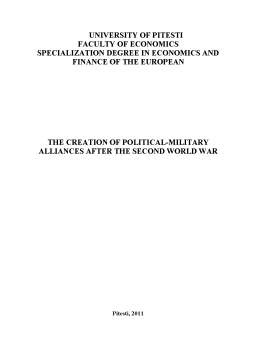Extras din proiect
The confrontation with twice the effort of reconstruction and security in the face of a Europe of the East under “satelization”, Western Europe will seek in the years after the war to succeed and to ensure the survival of using successively or simultaneously by using the American help and the desire of unification displayed by some of its leaders.
Immediately after the German surrender, the projects “pan-European” seem to take a particular scale. Only that it must be that those who formulate them to agree on the direction that it ends this expression. Times the views are different in terms of geographic and institutional framework of European construction.
Those who, like Winston Churchill in the resounding speech given in Zurich on September 19, 1946, considers that it must build the “United States of Europe” in the Franco-German axis, without the United Kingdom and on the principle of respect for the sovereignty of each State, allowed the objection to “federalists” which envisages the creation of a strong structure with a European Government and with full power by limiting the absolute sovereignty of the Member States.
From 1945 to 1947 will be numerous pan-European organisations, the most important being the European Union of Federalists, featuring personalities such as Henri Frenay, Marc Alexandre, Altiero Spinelli, Eugen Kogon and Henry Brugmans and which counts up to 100.000 members.
Others have been established on a basis more ideological, as the Socialist Movement for the United States of Europe, chaired by Andre Philip or New international teams with Nuance Christian-democratic. As far as it concerns on the count of Coudenhove-Kalergi, who retook the idea that a defended with Briand in the late 1920s, gathers around it a European Parliamentary Union which brings together a significant number of representatives of the people devoted federalists, from most Western European States.
From 1947, for most “unionists” and “federalists” has become clear that the European construction, any shape would coax, will not be able to achieve with the inclusion of States that have entered the sphere of influence of the USSR and therefore, in anticipation of better days, the project must be restricted to the countries of Western Europe.
For many, this is really the best wall of defense against expansion of communism provided heads a certain consistency and design differences disappear in this difficult time. In this perspective, in May 1948, three months later after “shot of Prague”, at the Hague is a “Congress of Europe” which brings together, under the honorary Presidency of Churchill almost 800 personalities belonging to the majority of the countries of Western Europe: politicians, businessmen, journalists, trade unionists, intellectuals, the most numerous being the British and French.
Although differences of opinion between the Union, especially the British, and federalists, represented primarily by the French, Italian, Dutch and Belgians, were manifested again and here, the Congress of the Hague has decided on the need for States to unite a part of their sovereign rights to coordinate and develop the resources as Germany is integrated into the new European framework and constitutes as soon as possible a Parliamentary Assembly to be elected by universal suffrage.
Until then, however, take its determination to create a European movement which, without replacing existing organizations, to have the mission to coordinate their work and to represent them in addition to Governments.
Creation on 5 May 1949 in London of the Council of Europe marks the end of efforts to end the war by partisans of European construction, based on cooperation policy. At the initiative of the President of the Council of Ministers belonging to the Popular Republican Movement French, Georges Bidault, 10 Western countries – France, the United Kingdom, Ireland, Belgium, the Netherlands, Luxembourg, Italy, Denmark, Sweden and Norway – decide to create common institutions, with strictly limited powers.
They include on the one hand a Committee of Ministers, composed of the Ministers of Foreign Affairs or their deputies who deliberates with the doors closed and vote unanimously in all cases significant and a Consultative Assembly, with its seat in Strasbourg, composed of delegates appointed by national parliaments.
During this time, the problems posed by the economic reconstruction of Europe and it’s defense have led Americans to get involved directly in the Affairs of the old continent and this on two planes: financial and political.
Early 1947 marked a turning-point in this regard in the politics that Americans leads in Europe. On 12 March, President Truman keeps in front of Congress a speech in which he defines his doctrine of “embankment” (containment) and which undertakes country in a massive financial assistance granted to countries that wish to remain free and who “resist to attempts of servitude, either they come from some armed minorities, either from external pressures”.
The enemy is clearly indicated, and the first beneficiaries of aid proposed are the two countries on the american President considers directly threatened by Communist expansion: Turkey and Greece. In Greece, where Communist partisans have resumed fighting against the Government of the United Kingdom supported the loyalist, British, Americans take place too concerned about their internal affairs to more able to play the role of the gendarmes of the “free world”.
Their intervention will allow a rapid stabilization of the situation in southern Europe and the Near East, and despite the generous aid that Stalin provides now the Greeks, the Royalist forces of Communists will get the Communist victory, the last refuge of Mount Grammos was occupied in October 1949.
Preview document
Conținut arhivă zip
- The Creation of Political-Military Alliances after The Second World War.doc
















